

To accomplish the science goals of ATom, every scientific instrument on the NASA DC-8 is tenderly cared for. In the case of the Single Particle Soot Photometer (SP2) an instrument for quantifying black carbon aerosol concentration, this care includes gentle heating after cold nights, frequent laser intensity calibrations, and renewal of drying agents used to produce conditioned air to keep laser components clean.
However, as in those occasions in which the instruments fail in one way or another, the most important component is not mechanical or electrical, but rather biological; the caretakers themselves need some coddling to ensure that they (we… I!) can think clearly and effectively when “push comes to shove”. During the ATom flights from Christchurch, New Zealand to Punta Arenas, Chile, and from Chile to Ascension Island, we traveled over 12 time zones in short order; long, warm showers and extra naps seemed to be the popular prescriptions to deal with this stress.
I highly recommend more regular maintenance during flights, in the form of carefully thought out meals. These provide not only calories, but also a welcome break from the potential monotony of the ATom flights; for black carbon, most of the excitement lies not in the second-to-second observation of the data stream, but rather in the global-scale trends in concentrations that we can extract from the measurements only after careful quality controlling and data analysis. Many on the DC-8 simply buy a fast-food sandwich before each flight (if departure times allow) and eat at their seats. I prefer to use the whole of the aircraft as kitchen and dining parlor.
Let’s take a look at the facilities: the DC-8 is equipped with a coffee machine (with hot water tap), a microwave (so old!), a hodgepodge of communal condiments and utensils, and a cooler stocked with water.
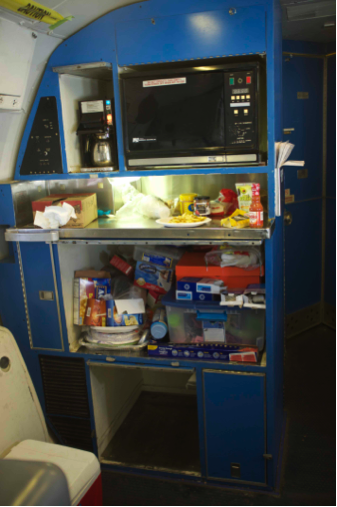
The DC-8 mess. Credit: Joshua Schwarz

The mess in action: Matt Berry (Mission Director) and Stacy Hughes (Whole-air sampling princess), bringing life to the rear cabin. Stacy is testing a new application of the microwave: to warm her hands because the flight was brutally cold. I think she was heating a New Zealand meat pie as her meal. Credit: Joshua Schwarz
In my experience, there are three foundational elements to a successful research-aircraft dining experience:
The first is fairly easy to achieve: quantity, quantity, quantity. All you need is plenty of candy. Now, flying to Ascension Island, I have a Chilean-version Kit Kat, Nutty Bars (a terrific ace in the hole, which I stocked up on in the U.S. before the mission began), NZ potato chips, apples, prunes (yum!), Crunchie bars, Crispy Rolls (from Chile, these appear to be chocolate-covered corn flakes), Sabor frambuesa batido (raspberry yogurt from Chile), a bag of pimiento olives, and a “sahne-nuss” chocolate nut bar, hummus, and carrots.
These are stashed on the floor between the SP2 rack and the wall, where a chilly breeze keeps everything refrigerated. Of course sweet drinks (hot chocolate and chocolate milk rate high, orange juice is a refined alternative, regional specialties are always worth trying (except for “L&P”, the exception to the rule, popular in New Zealand, but probably inspired by a marriage of Pinesol and simple syrup. Ugh!). This could be a little light for today’s 9 ½ hour trek, but extra treats from the rest of the ensemble can usually be begged. And one can always hope for unexpected treats – on the last flight Jim Elkins (NOAA) passed out macademia nuts; I remember a different mission where we celebrated crossing the equator with cookies.
The scale to a achieve a meisterwerk slides depending on many factors: the availability of foodstuffs at the departure airport (I remember leaving Easter Island with only ramen noodles); the quality of the rest of the crew’s meals (competition is growing more fierce); flight conditions (turbulence quickly narrows the range of possibilities – soups are OUT!); and one’s own standards for a fine dining experience.
My standards are happily very low in this regard. On the flight out of New Zealand, my magnum opus was nachos made with New Zealand tortilla chips (yellow corn, meh), hand cut cheese in the microwave (Colby, quite good), topped with Frank’s Original Hot sauce (one of my contributions to the kitty), and adorned with pureed avocado (the fresh avos in Christchurch were all rock hard). In the old days, simply bringing a frozen Indian meal (I’m a tikka masala man) was sufficient to set the bar. I do have plans to perfume a pig, and hope to extend a ramen soup with a fresh egg, cheese, and sesame oil. I considered making ceviche, but decided against the risking a fishy-smelling cabin for the rest of the mission.
To ensure that your meal is appropriately obvious to the others on the plane, I recommend a highly scented hot meal marched up and down the aisle as you eat. On the New Zealand flight, I used a “hot scotch toffee cake” to spread a warm glow of sweetness through the cabin. Leadership by example, I say! Let’s not let these hard-thinking scientists forget to keep every tool in their chest oiled and ready for use in the service of science, society, and high altitude gastronomy.
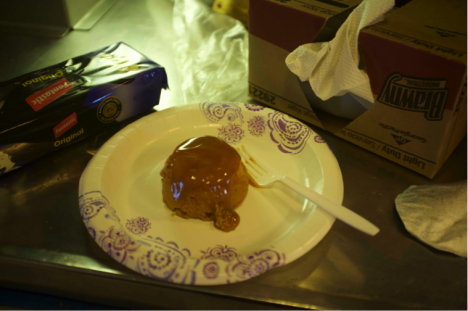
The “meisterwerk” hot scotch toffee cake. Credit: Joshua Schwarz
Joshua “Shuka” Schwarz is part of Chemical Sciences Division at NOAA and is investigating black carbon throughout the atmosphere.
By Eric Lindstrom
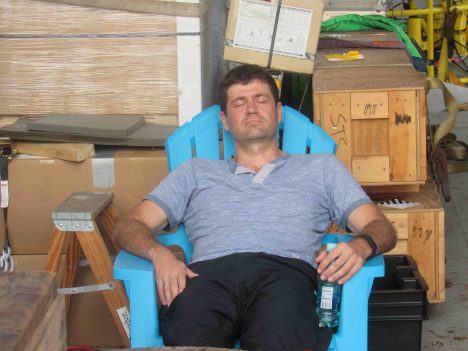
Denis Volkov taking a break from work in the afternoon.
One of the popular topics of conversation during the first week of the voyage has been sleep. Whether it is poor sleep, good sleep, disturbed sleep, or deep sleep, almost everyone in the science party has had something to say about the subject of sleep.
Sleep on a ship is special. As you can imagine, the rocking and rolling (actually pitching, rolling, and yawing) can be a gentle sleep inducement – unless it is making you terribly sick! What those on land probably cannot imagine are all the noises associated with the ship – the engines, equipment, and the sea slapping at the ship. An amazing array of new hums, grinds, bangs, bumps, slams, alarms and conversations must be assimilated into one’s sleep life.
After a week of hard work preparing the ship for sea in Honolulu, it is no surprise that many slept well the first night. However, the next couple days were much harder for some. The mild seasickness and the abnormal noises from the ship unsettled sleeping patterns. More than one person commented to me that their adjustment and best sleep came around day 5. By that time all the seasickness had past and the sounds of being at sea had been incorporated into ones dreams. Soon we will start weeks of 24/7 operations and the luxury of long sleeps may be over until the transit back to Honolulu. Sleep may get interrupted when operations call.

Audrey and Kristen during the early seasick times.
Many scientists will be on 12-hour watches (noon to midnight or midnight to noon) so one should not be too worried out lack of sleep among your favorite scientists. It is more likely that one’s normal rhythm of sleep may be at odds with duties.At sea it is not abnormal to find people eating, sleeping, exercising, and working at odd hours.
Part of writing about sleep now is because (at this writing on Sunday afternoon, August 21) we have completed our transit from Honolulu to 125W longitude and are beginning 24-hour scientific operations with a southbound trek along the meridian. We will be deploying drifters at regular intervals, profiling temperature and salinity while underway, and deploying three moorings along this meridian.
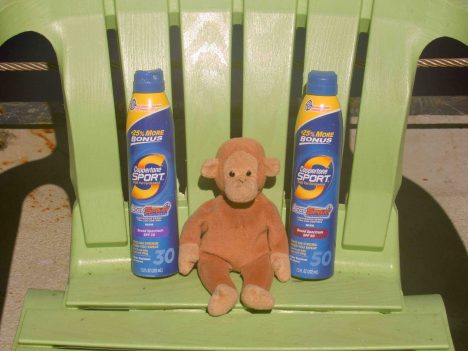
Monkey working on his “monkey tan” at steel beach.
Let me finish today with a little local story about sleep. Andrew Meyer, the mooring technician from the National Oceanic and Atmospheric Administration, has a son, Jack, who is 3 and a half years old. Jack sleeps with his plush toy Monkey every night. When dad left home for the SPURS-2 expedition, Jack sent Monkey along so Andy would not be lonely. So Monkey is having a good time, sending pictures to Jack and family regularly. Monkey is certainly helping Andy keep in touch with his loved ones and that also means that Monkey is helping Andy sleep better at night. So, dear readers, Monkey joins the blog today to honor all that we do to sleep well and to remember those we left at home as we work, and sleep.
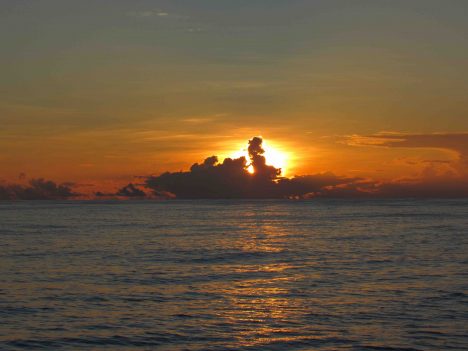
Sunset at sea on Aug. 21.
I leave you today with a sunset and hope that all of you will sleep well!
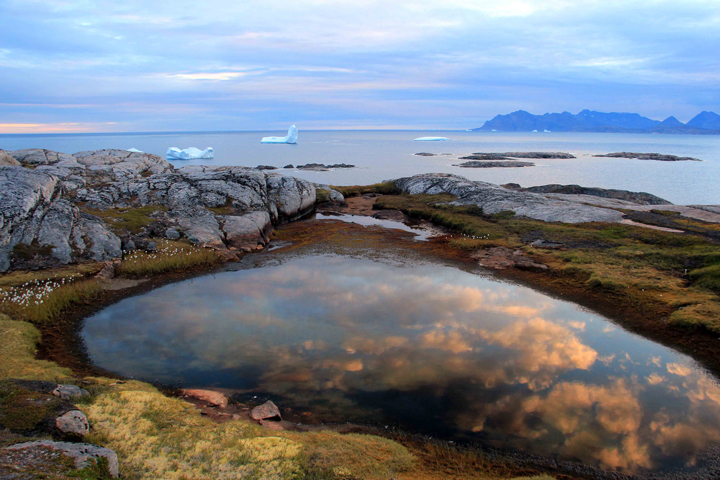
Nice cloud reflection on my last evening hike near the old harbor of Kulusuk.
Hi there,
Last blog post of for this field season, as Olivia mentioned in her science post, we were able to collect an important amount of high-quality data to further our knowledge of firn aquifers and try to answer the following research questions:
To learn more on how we try to answer these questions, I invite you to read Olivia’s post where each method is described in more details.
To wrap up, I am using bullet points and I am dividing them into themes: weather, camping, and science.
Weather:
Camping:
Science:
That is about it for our fieldwork summary, below, I have tried to summarize our work with photos in a chronological order. I hope you enjoyed reading the different blog posts and on the behalf of our team, I would like to thank you very much for following our journey in Southeast Greenland.
All the best and see you next time,
Clém

Preparing our first sling load at the airport (left), ready to be picked up by the helicopter a few minutes later (right)

Setup of our bear-proof camp. First, a trip wire which if tripped, triggers a loud alarm (sounds like a car alarm) and warn us about a possible encounter. The second layer of protection is a fence to shock the bear, and everyone had bear horns and bear spray. But we also carried a rifle in case the previous methods failed to scare the bear away.

Downloading data from both the Utrecht weather station (left) and our other station logging 50 temperatures in the firn and water-table level changes (right).
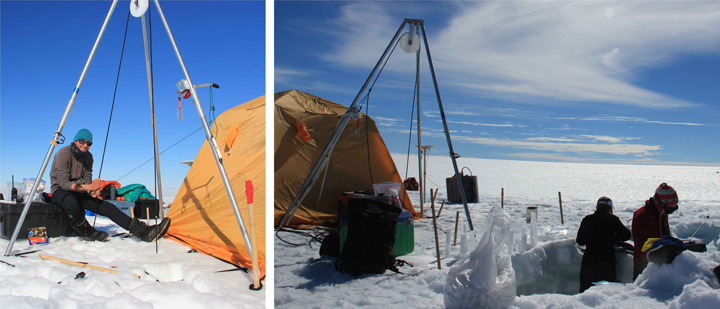
Drilling (left) and processing the firn and ice cores (right).
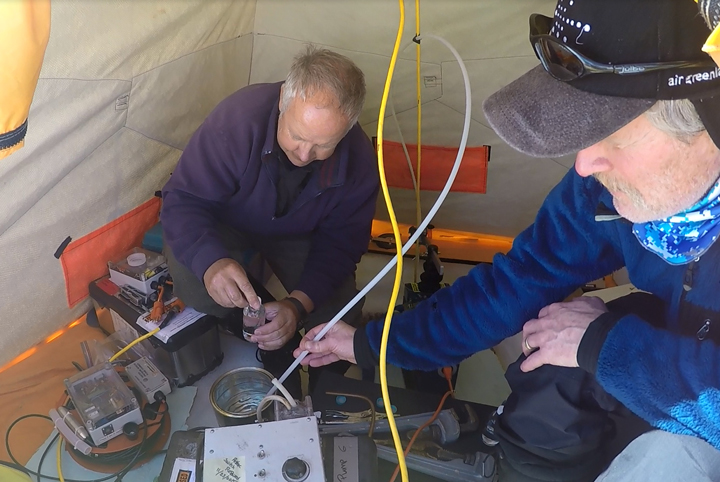
Kip and Rick sampling water from the firn aquifer.
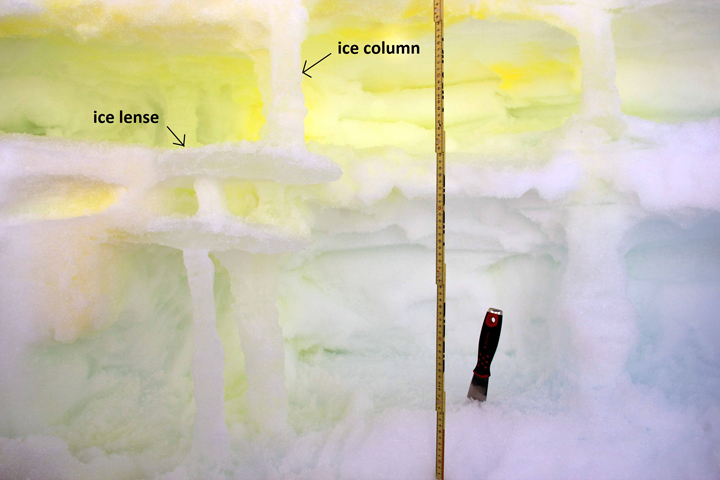
Excavating ice columns and ice lenses after spraying neon-green dye at the surface to look at water infiltration processes.
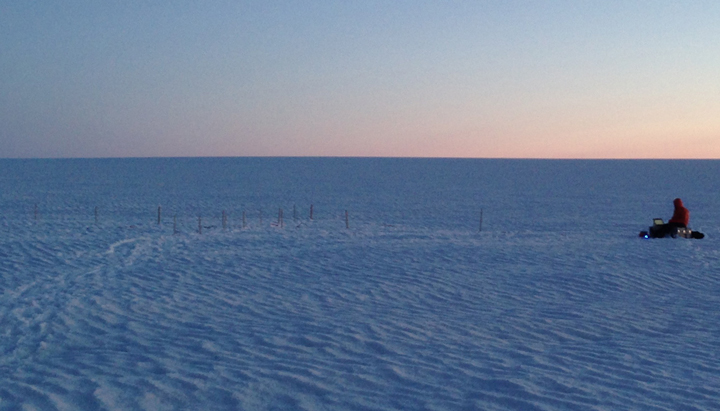
Working after dinner on a small-scale seismic survey in nice the evening light.
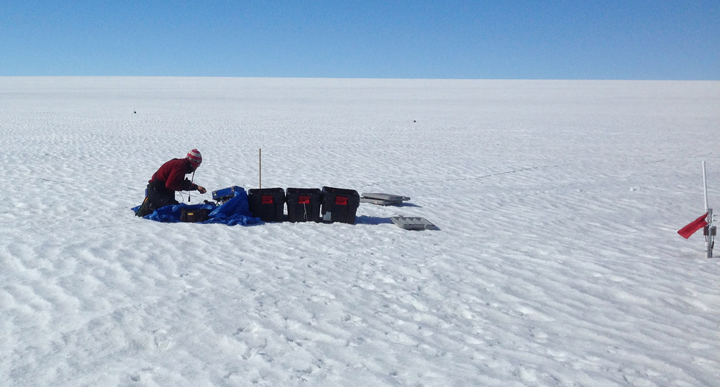
Getting the MRS measurement started after setting up the 80 by 80 m loop. On the right, one of our logging station after one year of data collection, only the top of the mast (ARGOS antenna) is above the snow surface.

Team photo on our last day with team members being hot in their ECW (extreme cold weather) gear! Actually, the tropical weather out there motivated us to pull out our leis too 😉
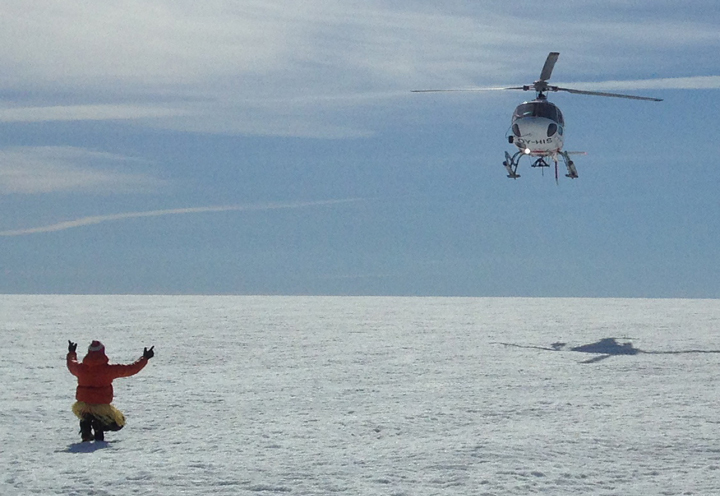
Aloha! After 20 days of work, the helicopter is coming back to get us, we greet with Hawaiian style!

Olivia hands our precious water samples to Johannes for loading them in the helicopter as our first priority.
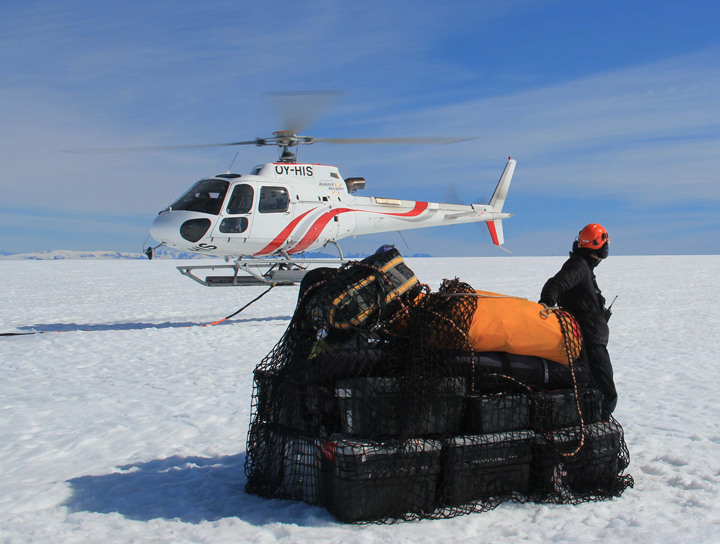
Nick (orange helmet) has the last sling load ready to go and is getting prepared to hook it on to the cable attached to the helicopter.
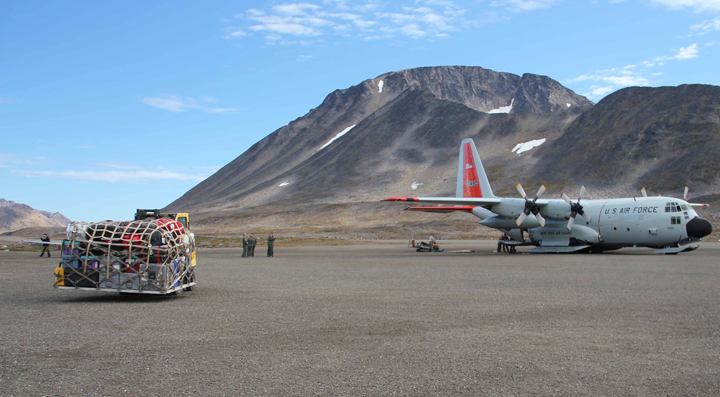
Back in Kulusuk, we spent a few days packing up the equipment. On the last day a LC-130 came from Kangerlussuaq to pick up a few thousand pounds of equipment. You can barely see the small forklift from the airport moving the Air-Force pallet at the back of the plane.
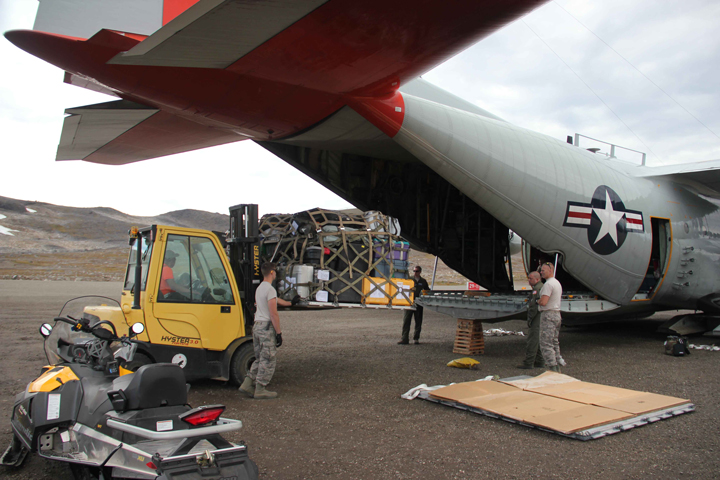
Loading up the science equipment into the plane.
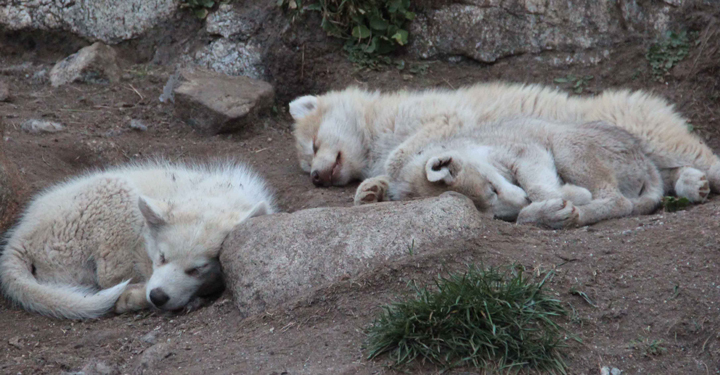
Peaceful and sleepy husky puppies in the evening.
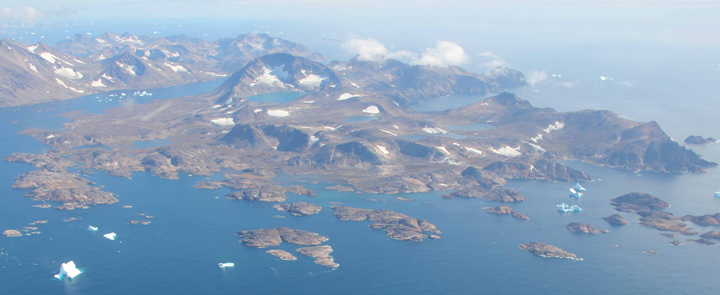
View of the Kulusuk Island from the air. At the left you can see the airport runway and on the right, you might be able to spot the DYE-4 station.
By Eric Lindstrom
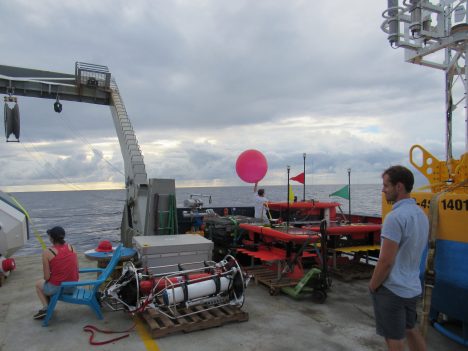
Launching a balloon from the R/V Revellle, for atmospheric sounding.
As I mentioned in a previous blog post, the R/V Revelle is bristling with meteorological sensors. Some are permanently installed aboard, some are just for SPURS-2, and some are on the moorings we will deploy. Raymond Graham, a graduate student at University of Connecticut, did a quick count of meteorological sensors and we were amazed to find out that on a ship of less than 300 feet we had deployed eight wind sensors, 16 air temperature probes, 15 humidity sensors, 15 rain gauges, 11 radiometers, and four barometric pressure sensors! The reason for the overkill is the critical nature of meteorology for our work and the difficulty of obtaining clean data from the ship. Wind and rain especially are notoriously difficult to sample because of flow distortions or shadowing around the ship. By deploying gear at a number of locations (bow, stern, bridge deck, etc.), we will more likely collect clean data no matter which direction the ship is headed relative to the wind. During analysis of the data, one ideal time series of ship data can be assembled from the numerous sensors based on ship heading and true wind direction.

Carol Anne Clayson at work on the bow mast.
For SPURS-2, a group from Woods Hole Oceanographic Institution led by Carol Anne Clayson and a group from University of Connecticut led by Jim Edson are gathering state-of-the-art measurements of key meteorological variables. They will estimate the transfers of heat, freshwater, and momentum between atmosphere and ocean. Today, for example, Jim Edson launched the first of their balloons for atmospheric sounding. The balloon carries a small expendable package that transmits temperature, humidity, and pressure data until the balloon pops in the upper atmosphere.
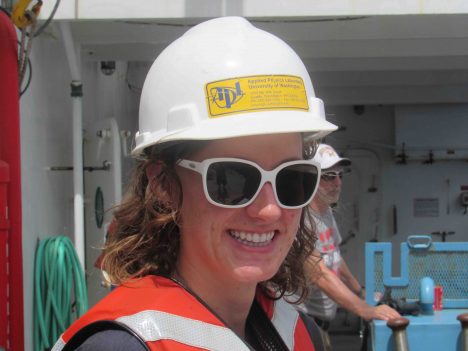
Elizabeth Thompson from the University of Washington’s Applied Physics Lab.
Elizabeth Thompson from the University of Washington’s Applied Physics Laboratory is also working the meteorological angles for SPURS-2 by providing the daily meteorological briefings and analysis of radar data (to help us track rain events). She and Audrey Hasson are providing daily briefings at 4 pm to apprise us of the weather and oceanographic conditions to be encountered over the next day of operations. For the moment they are practicing and perfecting the best information and products to utilize and share. Prediction sure is an activity to sharpen a scientist’s skills!
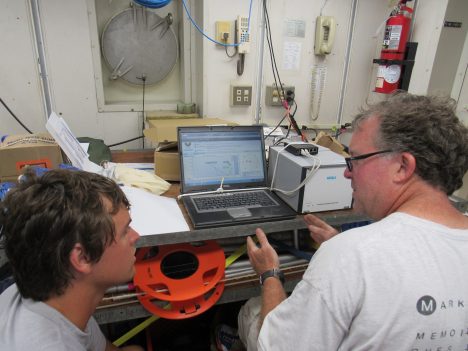
Jim Edson from University of Connecticut and Raymond Graham, a graduate student at U.Conn., looking over the first results from the balloon deployment.
While much of the time aboard Revelle is focused on oceanographic measurements, the meteorology is key to synthesis of the overall story of SPURS. In the end we will want to assess the ocean response to forcing – whether in the form of rain, wind, or sun’s radiation. It is quite difficult to tell the story of the near surface ocean without understanding how it is interacting with the atmosphere. Likewise, it is quite difficult to tell the story of the evolving atmosphere without understanding how it interacts with the ocean. This coupled system is an especially powerful engine for Earth’s climate here in the tropics. The warmer the ocean and atmosphere, the more energy in the form of water vapor is exchanged. Hurricanes are a good example of this interaction and exchange – and a reason to worry about stronger or more frequent hurricanes in a warmer world. Air sea exchange is very sensitive and very powerful when ocean waters are greater than about 83 degrees Fahrenheit (28.5 degrees Celsius) as is found in the deep tropics and here in the Intertropical Convergence Zone.
As the DC-8 flies around the world for the ATom project, we are crossing many time zones and occasionally loosing and gaining days! For most of the first half of the project, I didn’t really notice these time changes. I gained the most time leaving Boston for California and had one to two hourly stretches in the evening after that. This has meant that getting up for 4 a.m. pre-flights has actually been do-able! I thought I was doing great — for a night owl. We lost time last week when flying from American Samoa on Monday morning and arriving into New Zealand on Tuesday afternoon. But I had already lost track of the day of the week so that didn’t really have any impact on my routine. In New Zealand, I finally had the time to take a whole day off (for the first time in over 2 weeks!) so we explored Aoraki/Mt. Cook National Park for a few hours.

Snow blowing from the mountains onto the glacier in Aoraki/Mount Cook National Park, New Zealand. Credit: Róisín Commane
And then there was the flight from Christchurch, New Zealand to Punta Arenas, Chile.
We gained back the lost day and more as we flew 10 hours from Christchurch on Saturday morning to arrive in Chile at 4 a.m. on Saturday morning. My poor body clock has no idea which way is up! On the plus side, maybe this body clock mayhem will make the 3:30 a.m. wake up call for our pre-flight tomorrow slightly less ruthless? Wishful thinking perhaps.
But at least the flight from New Zealand was worth all the effort! We flew south from New Zealand to 65 degrees S, profiling from the top to the bottom of the atmosphere as much as we could. We saw Antarctic sea ice, lots of sea salt particles and not at lot of CO at the low altitudes, while at the highest altitudes we saw the Polar vortex and its -70 degrees C temperatures. We also saw CO2 over 401 parts per million (ppm) for most of the flight.

Watching the sun set mid-way through our flight from New Zealand to Punta Arenas, Chile. Credit: Róisín Commane
There is a wonderful exhibit in our hotel here in Punta Arenas about Shackleton’s Trans-Antarctic Expedition (1914-1917) from Chile to Antarctica, which included the great Irish-man Tom Crean. Disaster befell the expedition in Antarctic waters and resulted in five men (including Crean and Shackleton) sailing a 20-foot boat across 700 plus miles of Southern ocean to get help. After seeing the choppy seas of the Southern Ocean on our last flight, I have no idea how they found the island of South Georgia. But hopefully we will have just as good luck as they did when we venture east again to find Ascension Island in the middle of the South Atlantic tomorrow.
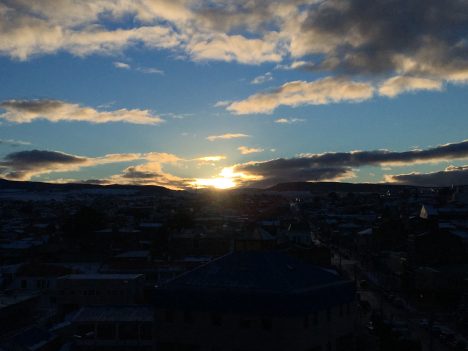
Our first sunset in Punta Arenas, Chile. Credit: Róisín Commane